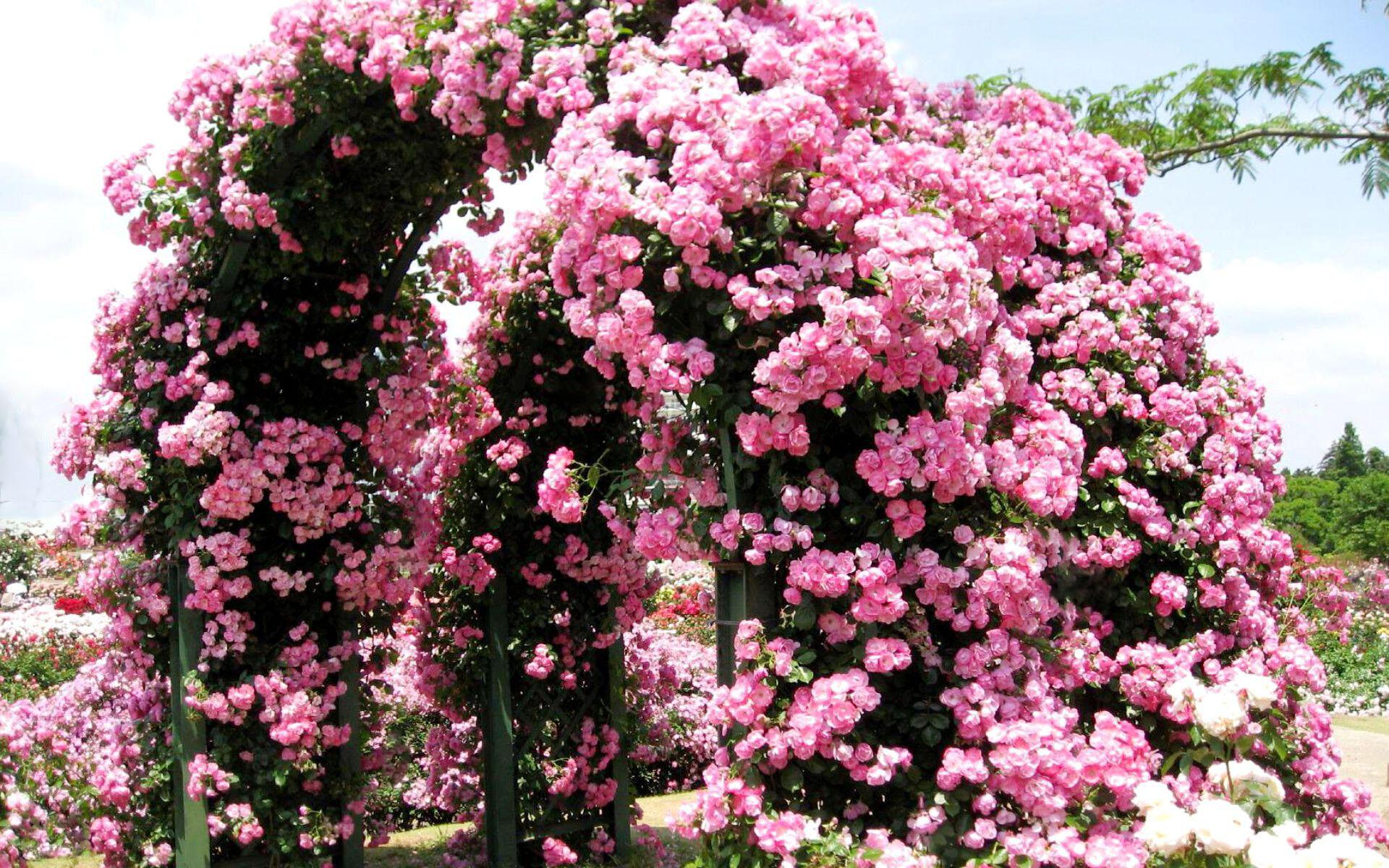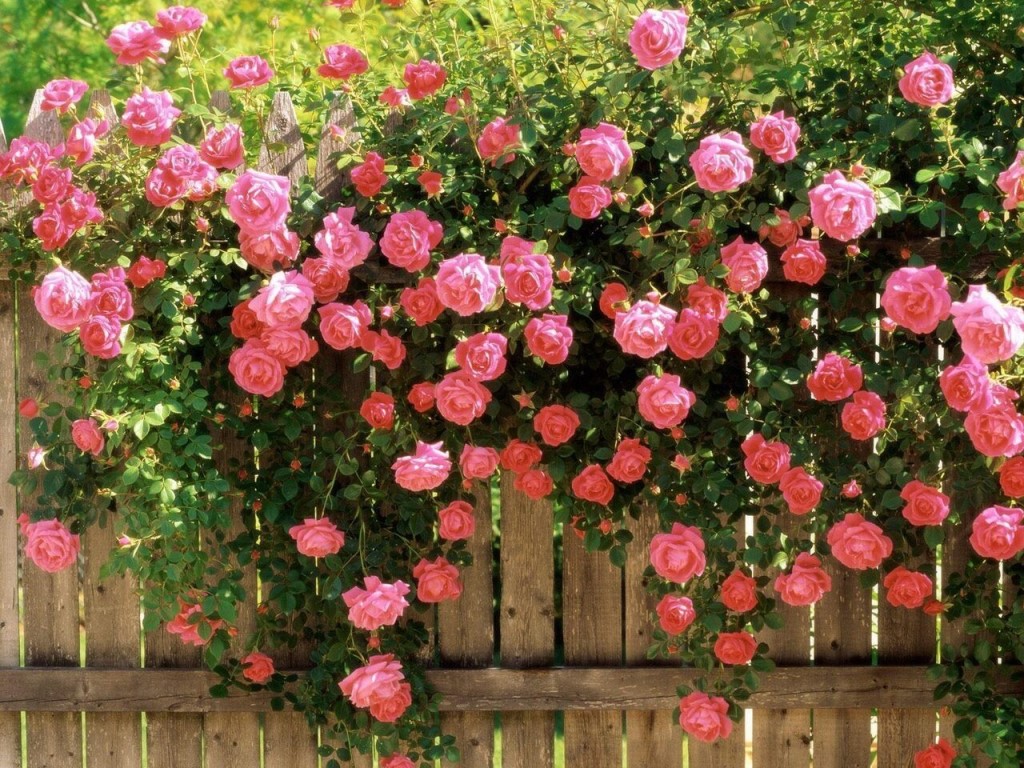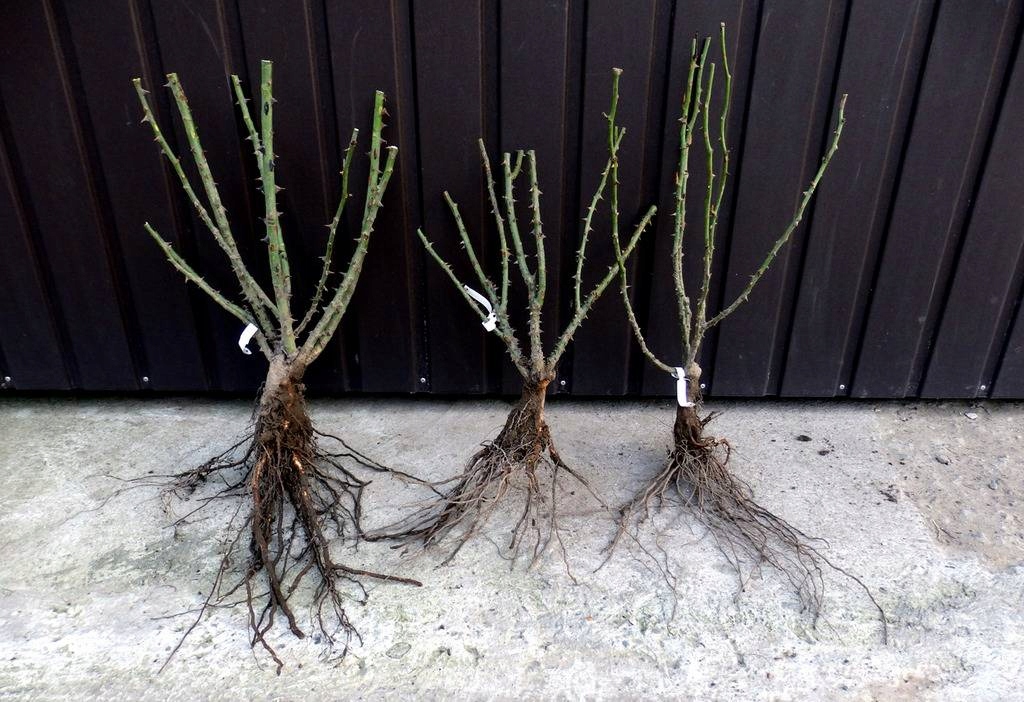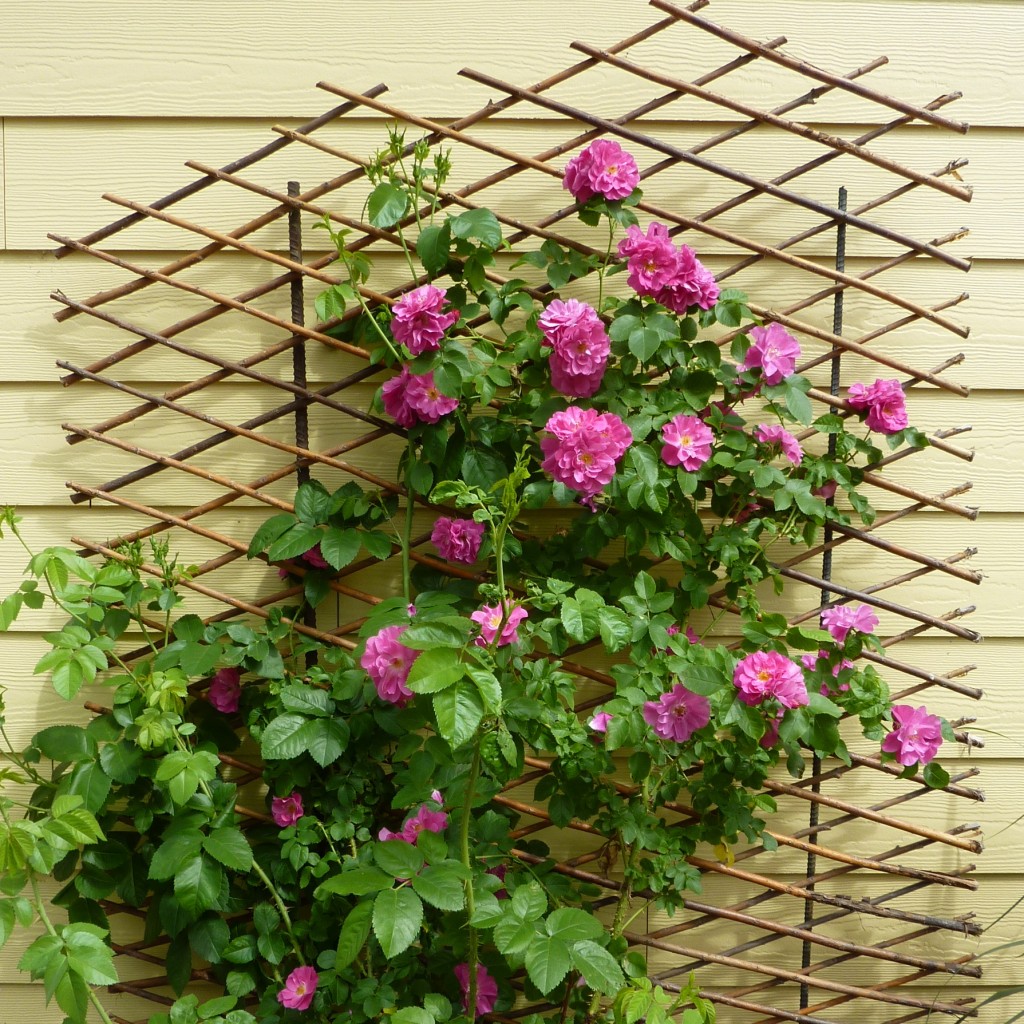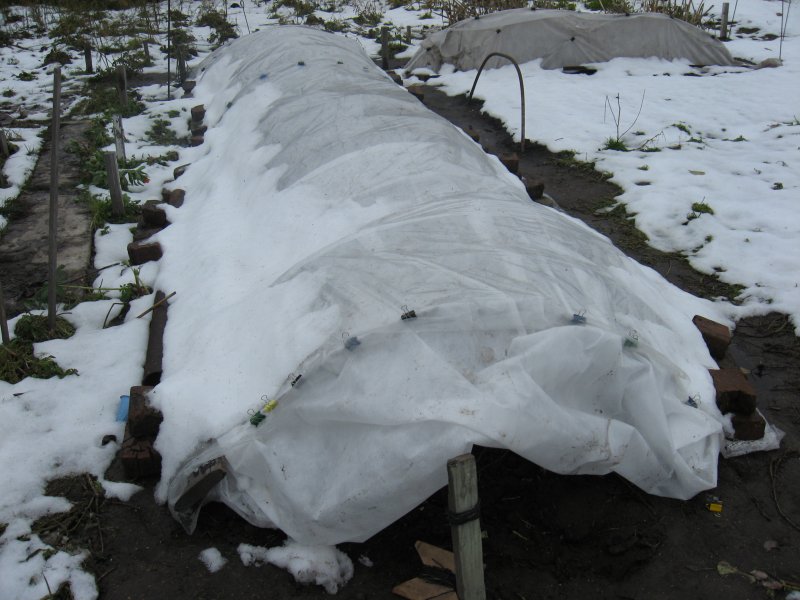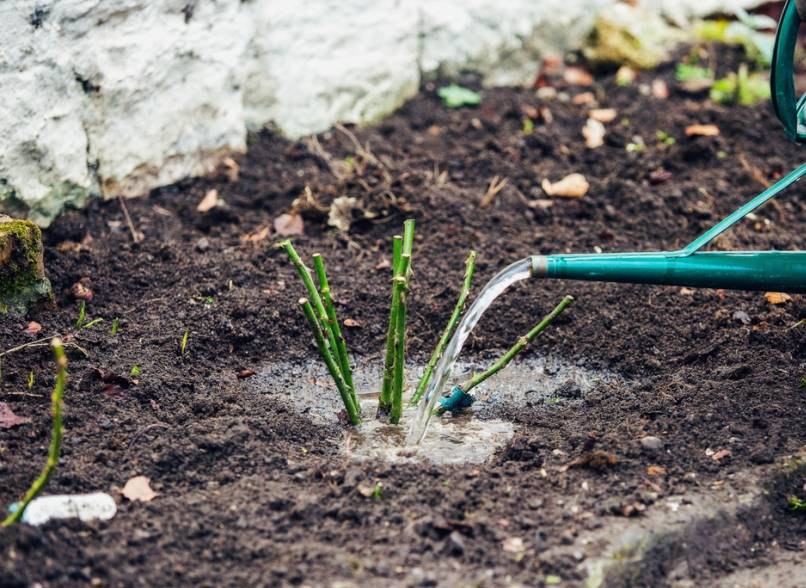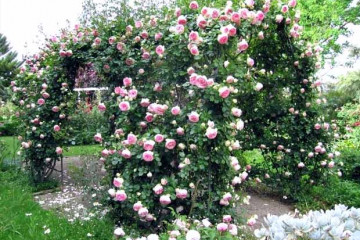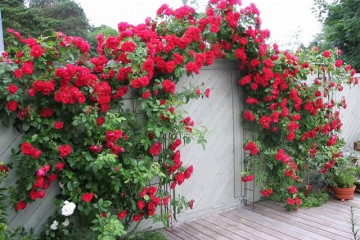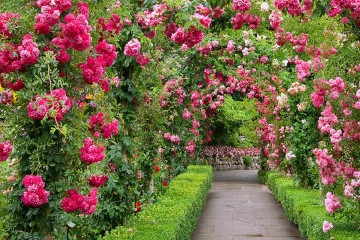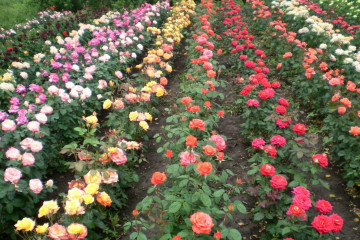Climbing rose - planting and care outdoors in spring
Content:
Climbing roses are beautiful, profusely blooming perennials that decorate flower beds and park compositions. The plant's powerful shoots help mask unsightly corners of the site. Modern agricultural technology and a selection of hardy varieties allow successfully planting and caring for a climbing rose in the open field, even in the Urals and Siberia - regions with a harsh continental climate.
Planting a climbing rose in open ground
Spring planting of the plant is more preferable in all climatic zones, except for the southern regions. Bushes planted in autumn do not have time to fully form the root system, the shoots do not ripen. Chances are high that the rose will not survive the winter.
Optimal time for planting roses
The terms when you can plant climbing roses in open ground, depending on the region:
- in the south - April-early May;
- in the middle lane - from the end of April to the end of the last spring month;
- in the Urals and Siberia - from late May to mid-June.
You should not blindly focus on the indicated dates when you can plant a climbing rose - nature is capable of any weather surprises. As a rule, planting is carried out at the end of the period of severe frosts, reaching the average daily air temperature of +10 degrees, warming the soil to a temperature of + 10-12.
Choosing a place and necessary conditions
To grow a climbing rose, great attention must be paid to choosing the optimal place for the plant. It should be borne in mind that the flower grows strongly, in an adult state it will need a lot of free space. In advance, it is necessary to provide for the presence of a place for laying shoots when sheltering for the winter.
Lighting and humidity requirements
Roses are light-loving plants; for their full development, the bushes must be illuminated by the sun for at least 8 hours a day. Growing up in the shade, perennials often get sick, bloom poorly. For a climbing rose, it is difficult to choose a place with good lighting. They are planted along high fences, near the walls of buildings, where shading occurs for part of the day. It is recommended to grow a flower from the southeast or south side, where the plant will be under the morning sun, in the afternoon - in partial shade.
Roses prefer 40-70% humidity. Such conditions are created in the open field in a natural way. Perennials should be planted in ventilated areas, but not in drafts. The climbing rose needs protection from the northerly winds. To ensure free air circulation, when planting bushes near walls and fences, you must maintain a distance of at least 60 cm.
The roots of the culture go 1-1.2 m deep into the soil. For perennials, areas with a close occurrence of groundwater are not suitable. If the place is damp, water stagnates in it in the spring, a raised platform is erected for the rose and enhanced drainage is made.
Soil preparation
The rose grows well on cultivated fertile loams with a neutral or slightly acidic reaction (pH 5.5-7). The soil should be loose, water and air permeable.
Planting pits are prepared in the fall. If this is not possible, they should be done two weeks before the event. During this time, the soil settles, nutrients are evenly distributed. The pit should be 70 cm in diameter, 60 cm deep. Drainage from expanded clay, crushed stone or broken brick with a layer of 10-15 cm is laid on the bottom.
The composition of the nutrient mixture depends on the characteristics of the soil of the site. Sand and peat are added to heavy soils, and clay to sandy loam. The approximate composition of the substrate for the planting pit:
- a bucket of fertile soil from the topsoil;
- 5 kg of humus;
- 5 kg of peat and sand in a 1: 1 ratio;
- 0.5 kg of wood ash or 0.3 kg of dolomite flour;
- 50 g superphosphate;
- 30 g of potassium magnesium.
How to choose a seedling and prepare for planting
It is better to buy seedlings in specialized nurseries. In the markets and in chain stores, the rules for storing plants are violated, which leads to drying out of the roots and stems, premature foliage blooming.
Before purchasing a climbing rose, it should be carefully examined. What a good seedling should look like:
- the root system is strong, well developed, without signs of rot and mold;
- green elastic shoots, shriveled brown twigs should be absent;
- the kidneys are alive, slightly awakened.
Seedlings of climbing roses with a closed root system - plants planted in a container. They are convenient in that they do not require immediate planting, but do not provide an opportunity to assess the state of the root system. Purchased in early spring, roses are kept at home. On warm days, they are placed in shady, windless areas of the garden, digging containers into the ground to prevent the earthen coma from drying out.
Before planting, it is recommended to soak the root system for a day in a weak solution of potassium permanganate. Then place for 3-4 hours in a solution of a growth stimulator ("Zircon", "Kornevin"). Broken shoots should be cut, damaged roots should be shortened until healthy tissue appears. Sprinkle the cuts with crushed coal or grease with 0.2% Fundazole solution.
Planting work - step by step instructions
Planting a climbing rose in spring in open ground is carried out on a dry, cloudy day. If there are sunny days, perennials should be planted in the late afternoon.
Climbing rose planting technology:
- At the bottom of the planting pit, make a slide of the substrate, put a seedling on it, distribute the roots around the perimeter. The vaccination site should be located in a southerly direction.
- The earth must be covered with layers, periodically watering and tamping the soil. It is important to achieve a dense filling of the planting pit without the formation of air pockets, which can lead to decay of the root system.
- When planting, it is necessary to ensure that the root collar is deepened by 10-12 cm. Roses in containers are planted in such a way that the upper part of the coma is 5-7 cm below the edge of the pit.
- Stick in a wooden stake - a temporary support to immediately tie the plant.
- Completely fill the planting hole with soil, carefully tamp it, make sides around the edges so that the water is absorbed and not drained.
- Water the rose abundantly.
Features of care after planting
In order for the rose to form a strong root system over the summer period, its shoots had time to ripen before the onset of cold weather, the plant needs to be intensively looked after.
The first time after planting, it is necessary to maintain constant soil moisture around the flower. A perennial is watered every day in the morning or in the evening with settled warm water, gradually switching to the number of waterings 2 times a week.
The soil around the shrub must be covered with compost, peat or sawdust. This allows you to maintain a constant water and temperature balance of the soil, prevents weeds from clogging the planting circle. For better air exchange, the ground under the bush is regularly loosened.
Prevention of fungal diseases should also be carried out by spraying the plant twice in late spring and in July with a 1% solution of Bordeaux liquid. When aphids and leafworm caterpillars appear on young shoots, insecticides are used.
During the summer, supportive feeding is carried out with a weak mullein solution. The buds that appear on the rose in the first year of the growing season should be pinched. All the forces of the plant should be directed to the development of roots and the growth of green mass.
When to tie
The climbing rose produces long shoots in the first year after planting and needs a garter. The even distribution of the lashes provides access to sunlight and gives the plant a decorative effect. Pergolas, arches, wooden or metal nets can be used as a support for a perennial flower. They are installed in the first year after planting a climbing rose, so as not to damage the growing root system in the future.
The rose cannot independently trail along the supports, the shoots must be tied. The scourge should not come into contact with metal structures or lean against the wall. A wooden trellis is installed at a distance of 30 cm from the wall along which the plant is planted.
Ways to tie a climbing rose:
- horizontal - the lashes are tied to the slats located in the horizontal plane;
- spiral - shoots are fixed around the support;
- vertical - the whips are fixed in an upright position;
- fan-shaped - bush branches are attached to the supports in the form of a fan.
Shelter for the winter
In the first year after planting, the plant should be especially carefully protected from frost. The young shrub has not yet matured and may freeze out. In September, it is prepared for wintering: phosphorus-potassium fertilizer is introduced into the trunk circle, and sanitary pruning of shoots is done. During leaf fall, plant debris is removed. The flower is spud up to a height of 20-30 cm or sprinkled with dry mulch.
When the air cools down to slight negative temperatures, the shoots are tied with twine and laid on a layer of spruce branches. Arcs are installed on top and agrofibre is stretched. Work is carried out in dry weather, the shoots should not be damp, otherwise they will mate. In winter, snow should be thrown over the plantings, creating additional protection from frost.
Open spunbond carefully in spring. Bright sunlight can do more harm than frost and cause serious burns. The shelter should be removed gradually, opening it for several hours in cloudy weather, allowing the plants to get used to the light.
Difficulties of spring planting
In the spring, when the plants are devoid of leaves, it can be difficult to assess how the garden will look in the summer. You need to choose a place where you need to plant a climbing rose in the summer-autumn period. Before buying, the gardener must prepare a support for the flower, read the recommendations on how to tie climbing roses.
In spring, a suitable period for planting roses is rather short: you cannot plant during a drought, during cold snaps, in rainy weather.It is important to choose the right time when the plant should be planted in open ground.
When planting climbing roses, it must be borne in mind that the flower does not tolerate the change of climatic zones. Seedlings should be purchased in local nurseries; you should not buy planting material brought from the southern regions.
If the purchased seedling has an open root system, it should be planted in the ground as soon as possible. In a situation where the rose is purchased, and the planting pit is not prepared, the roots should be wrapped in damp burlap and stored in a dark, cool place with good ventilation for up to 10 days. If a longer period of time is required, the rose can be temporarily buried in an inclined position.
After planting, the climbing rose needs daily care. This can create certain difficulties for summer residents who come to the site in the spring only on weekends. Mulching the soil helps to partially solve the problem.
The climbing rose, which is important outdoors in spring, will grow for many years to come. With the right choice of a seedling, adherence to planting technology and proper care of the plant, the probability of successful survival of a perennial in a new place is more than 90%.
